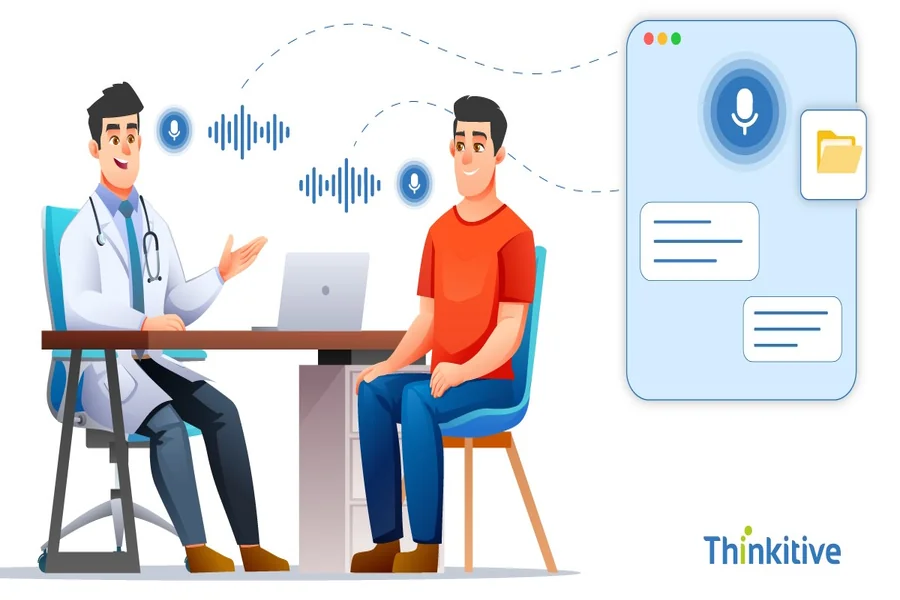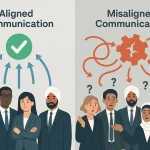When we look back today, we will find many things have changed and evolved from their initial forms to something completely different. One such change that made the lives of healthcare professionals much easier and stress-free is voice dictation.
Back in the 1990s, providers were recording voice and manually transcribing the details, but now recording and transcribing happen in real-time, and with accuracy. If we track where this change happened, then it will be the 2010s where artificial intelligence (AI) and natural language processing (NLP) entered the field.
At first, the tools for dictation were slow and inaccurate as the vocabulary needed was limited, and they did not understand medical terminology. This led to errors and delays in patient care decisions. However, with voice AI in healthcare, it changed, while ambient scribing and NLP in medicine made transcribing highly accurate and smooth.
This AI-powered transcription is streamlining documentation, reducing burnout, and giving providers back their time for patient care. Whether it’s through ambient scribing or real-time clinical summarization, this evolution is making healthcare documentation easier and faster.
So, if you are still relying on old dictation, then it’s time to upgrade to a more accurate and faster way. This blog will tell you how bringing AI into transcription is beneficial for you, whether you are a primary care provider or a specialty service.
The Great Voice Evolution: From Dictation Dinosaurs to Intelligent Clinical Partners
The voice AI in healthcare has changed the documentation and transformed the burden into a benefit for providers. However, healthcare voice technology was not like what it is today in the 1990s and the early 2000s. Doctors used basic voice recorders, and transcribing was mostly manual, which means everything was slow and with additional steps, delaying care decisions.
Traditional dictation could not understand complex medical terms, leading to poor accuracy and a lack of clinical context. These systems just capture words without knowing their importance, leading to providers spending time reviewing and editing notes. Moreover, they were not able to connect with other healthcare systems, creating data silos and care coordination issues.
But this changed with the introduction of voice AI in healthcare and natural language processing alongside machine learning. Modern AI voice systems understand what you are saying and can pick up on medical terms, abbreviations, and even the way different doctors speak.
Additionally, machine learning helps in improving the system over time with data, and the more they are used. AI can now transcribe conversations in real time, and you don’t have to wait for the transcript. With all of this, the correction and editing required is low, and errors are reduced drastically compared to old dictation tools.
Most importantly, these clinical voice AI tools can integrate with healthcare systems and EHRS, automatically updating patient files. Collaboration between care teams is enhanced as files can be shared instantly across teams. And with routine tasks like scheduling and reminders handled by AI, clinicians can focus more on meaningful work.
Ambient Intelligence: The Invisible Clinical Assistant
Nowadays, when any patient encounter happens, providers are not busy taking notes or understanding and sorting them afterwards. With technologies like ambient scribing, which listen to conversations and seamlessly integrate with EHRs, doctors can fully focus on what the patient is saying. This means the patient gets the doctor’s undivided attention, and details are stored and updated in the EHR.
Moreover, these AI-powered transcription tools not only listen, but at the end of the encounter, the provider gets a structured clinical note. With the right format and data points, the SOAP notes are generated in real-time, eliminating the efforts and time spent on charting.
The feature that makes AI scribing excellent is its ability to distinguish between multiple speakers in a clinical setting. It identifies whether the patient is telling symptoms, the nurse is giving vitals, or the physician is outlining treatment, and assigns it correctly in the transcript. This boosts accuracy, especially in high-volume, team-based environments.
These modern transcribing tools do not just hear, they understand the terms used by providers. With the power of AI, NLP in medicine, and machine learning, it recognizes medical jargon, specialty-specific terms, and workflows clearly. It can adapt to any scenario and maintain accuracy and speed of transcribing, whether it is cardiology or behavioral health check-ins.
In short, voice AI in the healthcare environment is taking physician voice notes to completely new levels in usefulness. With less effort, the results are increasing with improved decision-making abilities, and patient outcomes can improve significantly.
Voice Analytics: Unlocking Hidden Clinical Insights
When you are talking to a patient, every word holds importance as it can be key to accurate diagnosis and then to finding a cure. However, with traditional voice analytics tools, the chances of missing something are significant, and it can be dangerous for patient safety. This is where modern AI tools come in with built-in NLP in medicine and healthcare speech recognition features.
Here’s how this helps in unlocking better clinical insights and makes care delivery easier and accurate:
| Voice Analytics Feature | Clinical Value |
| Clinical Pattern Recognition | Identifies diagnostic and treatment cues from provider-patient conversations using NLP in medicine |
| Emotional Intelligence Analysis | Detects signs of depression, anxiety, or cognitive decline through tone and word choice |
| Quality Assurance Intelligence | Ensures conversation completeness, protocol adherence, and flagging of missing documentation |
| Predictive Clinical Insights | Uses machine learning to assess voice data for risk factors, future complications, and proactive interventions |
Intelligent Diagnosis: Voice-Powered Clinical Decisions Support
The AI tools not only understand what patients and providers are talking about, but they can also provide a probable diagnosis based on symptoms. With this, the providers’ work is made easier as they have a starting point for diagnosis, saving them time on analyzing and then coming to a conclusion. Let’s see how this becomes possible:
- Symptom Analysis Intelligence: Modern voice-based diagnosis tools can interpret a patient’s symptoms and transform them into actionable clinical insights instantly. Plus, these tools can suggest possible conditions and guide providers through the diagnostic process more effectively.
- Clinical Reasoning Tools: Providers now have a guide or assistance that helps them with decision-making through voice-guided reasoning. Based on the data of the patient’s symptoms, it asks follow-up questions with reasoning and speeds up the clinical decisions. This proves useful in differential diagnosis in complex and ambiguous cases.
- Evidence-Based Recommendations: These voice AI systems can easily surface evidence-based guidelines during an encounter, along with the relevant medical literature. This allows providers to make well-informed decisions without losing context or switching between screens.
- Risk Assessment Integration: Intelligent diagnostic voice system not only considers the present symptoms, but also takes into consideration patient history, comorbidity, lifestyle risks, and more. This results in a more holistic diagnostic picture, boosting accuracy and patient safety at the point of care.
With this, the voice AI systems make decision-making a well-informed process, enhancing the results and ensuring safe patient treatment.
Specialty Applications: Voice AI Across Medical Disciplines
Although voice AI tools help out in patient encounters, they are not limited to that. It can be used in different specialities by tailoring it to align with the medical disciplines. From high-pressure emergency rooms to psychiatric evaluations, specialty voice AI systems are transforming how clinicians document, communicate, and make decisions.
Here’s how different fields are leveraging clinical voice AI solutions to improve outcomes and efficiency:
| Medical Specialty | Specialty Voice AI Application |
| Radiology | Medical voice applications assist radiologists by enabling voice-based image interpretations, streamlining report generation, and improving communication of findings. |
| Surgery | In the operation room, voice-integrated surgical systems help with hands-free documentation, intra-team coordination, and real-time procedural guidance. |
| Mental Health | Voice AI for mental health can detect emotional cues, support mood tracking, and offer insight into cognitive patterns to enhance therapeutic interventions. |
| Emergency Medicine | Voice AI in emergency care supports rapid triage, captures critical case data in real time, and guides clinicians through urgent care protocols hands-free. |
Conclusion
From the early 90s to till now, the voice dictation system has evolved, and with AI and NLP in medicine, it has revolutionized transcribing. With ambient scribing, taking clinical notes has become much easier, and providers are able to focus more on the patient instead of taking notes.
Many think that the systems are hard to implement, but with proper planning and environment, it is much easier to implement. Plus, it gives a competitive advantage by saving significant time spent on reviewing and editing the SOAP notes.
So, want to take your note-taking from manual to automated? Thinkitive can make it possible. Click here and let’s get started.
Frequently Asked Questions
How does modern voice AI in healthcare differ from traditional medical dictation systems?
Modern voice AI goes beyond the old dictation systems. It doesn’t just transcribe, it understands context, extracts key data, and integrates directly into EHRs. While traditional systems needed heavy editing, today’s AI can auto-summarize visits, flag issues, and even suggest next steps. It’s smarter, faster, and way more advanced than dictation in the 1990s.
What is ambient scribing and how does it improve clinical documentation?
Ambient scribing uses AI to passively listen during patient visits and automatically generate clinical notes in real time. It frees doctors from typing, reduces burnout, and ensures more accurate, detailed documentation so that providers can focus on patients, not paperwork. It’s like having a smart, invisible assistant in the room.
How accurate are AI-powered transcription systems for medical terminology?
AI-powered transcription systems have become impressively accurate, with medical terminology often exceeding 95% accuracy in controlled environments. However, real-world results can vary based on audio quality, accents, and background noise. Still, with proper training and customization, they drastically reduce errors compared to manual transcription.
Can voice analytics help with clinical diagnosis and patient assessment?
Yes, voice analytics can support clinical diagnosis by detecting vocal biomarkers linked to conditions like depression, Parkinson’s, and respiratory issues. By analyzing tone, pitch, and speech patterns, it offers real-time insights that help providers assess patient health more accurately, especially in mental and neurological care.
What are the privacy and security considerations for voice AI in healthcare?
Voice AI in healthcare must protect sensitive patient data by ensuring HIPAA compliance, using strong encryption, and limiting access to authorized users only. There’s also the risk of voice data being intercepted or misused, so secure storage, anonymization, and ethical AI use are absolutely essential.
How do voice-based diagnosis tools integrate with existing EHR systems?
Voice-based diagnosis tools integrate with EHR systems through APIs and HL7/FHIR protocols, allowing spoken clinical notes to be automatically transcribed, structured, and uploaded into patient records. This seamless connection reduces manual entry, saves time, and ensures that documentation stays accurate and up-to-date in real-time.
What ROI can healthcare organizations expect from implementing voice AI technology?
Healthcare organizations can expect strong ROI from voice AI through faster documentation, reduced admin workload, and improved provider efficiency. By automating routine tasks, voice AI frees up valuable clinician time, cuts transcription costs, and enhances care quality, often delivering noticeable returns within months of implementation.
How does NLP in medicine improve clinical decision-making processes?
NLP in medicine helps doctors make faster, smarter decisions by turning messy clinical notes, EHR data, and patient histories into clear, usable insights. It spots patterns, flags risks, and surfaces key details, cutting through data overload so clinicians can focus on what really matters, and that is patient care.
What training do healthcare staff need to effectively use voice AI systems?
To use voice AI effectively, healthcare staff need hands-on training in voice commands, system navigation, and clinical documentation workflows. They should also learn error handling, data privacy protocols, and how to adapt voice tools to their specialty. Regular refreshers help keep usage accurate and efficient.
How long does it take to implement voice AI technology in a healthcare setting?
Implementing voice AI in healthcare typically takes 4 to 12 weeks, depending on the system’s complexity, EHR integration, and staff training needs. A phased rollout helps minimize disruptions while allowing teams to adapt. The key is starting small, learning fast, and scaling smart.






